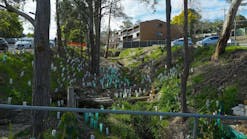City Stabilizes Banks After Flooding
The City of Owensboro, Ky., faced a large problem. Erosion from flooding caused the banks of Persimmon Ditch, one of the city's main drainage ditches that runs behind a residential neighborhood, to collapse.
“There was a lot of subsidence that was compromising public utilities,” said Jonathan Nieman, design engineer from CDP Engineers. “Backyards were starting to cave in and slump off into the stream.”
Engineers for the city needed a way to stabilize the banks of Persimmon Ditch before any further damage could be done. Given a six-month time frame, the city was challenged with designing and installing a storm channel solution that would solve its problems for good.
The Solution
City engineers chose Redi-Rock gravity blocks to design five different walls in order to stabilize the banks along this ditch.
Redi-Rock is a precast, large-block retaining wall system that uses the power of gravity to build tall retaining walls without the need for additional reinforcement in many applications. Redi-Rock blocks stack together like giant Lego blocks, so they install quickly with minimal excavation required.
“How quickly it went together really helped our schedule with this project, considering the short time frame we had to get complete,” said Sean O’Bryan, assistant city engineer for the City of Owensboro.
As construction began, the design and install teams ran into several challenges, including working in poor soil conditions with silty clay.
“We found that using the Redi-Rock block gravity wall was good because we were able to minimize our excavation and we didn’t have to use grid, which would have required us to excavate further back into the bank and take land that wasn’t within our easement,” Nieman said.
Navigating around nearby utilities was another challenge that presented itself during construction.
“One of the things that was interesting about this project was that there were existing manholes in the creek, and we had to change the wall alignment to accommodate a lot of utilities that were very close to the base of the wall,” said Clint Hines, principal at JC Hines & Associates. “There were a lot of special details that had to be developed, and it was nice to use the Redi-Rock system because there are so many specialized products.”
The Outcome
In total, more than 7,000 sq ft (650.3 sq m) of Redi-Rock in the cobblestone texture was used to complete the project.
“Everybody here loved the look,” O’Bryan said. “It's something that we’ve actually looked at using elsewhere, mainly because it is something that is pleasing to look at and it’s going to hold up the banks from eroding away.”







